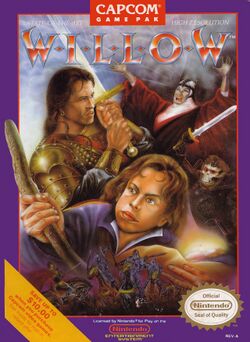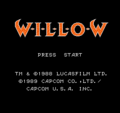
| Willow | |
|---|---|
| Developer(s) | Capcom |
| Publisher(s) | Capcom |
| Year released | 1989 |
| System(s) | NES |
| Preceded by | Willow (arcade) |
| Series | Willow |
| Genre(s) | Action RPG |
|---|---|
| Modes | Single player |
Willow is a 1989 2D action RPG developed and published by Capcom for the NES. It is loosely based on the 1988 film of the same name and is the second title Capcom released based on Willow that year, the first being an unrelated side scrolling arcade game. The version of Willow released for the NES and the Famicom is an adventure game in the vein of The Legend of Zelda.
-
Japanese Famicom box
-
European NES box
-
Game title
Story
At the beginning of the movie, Ethna the midwife flees from Nockmaar castle with baby Elora Danan, but Bavmorda's troops and hounds reach her. Moments before her death struggle, she puts Elora Danan on a raft down a river. Thus, Willow finds the baby and his adventure starts.
What if Ethna managed to escape the Nockmaar hounds? Where was she going with Elora Danan? The developers at Capcom started from these questions and created this role-playing game with a new plot and additional characters.
Ethna managed to bring Elora Danan to the safety of the Sacred Towers. As in the movie, the promised baby chose Willow as her protector, and the High Aldwin of the Nelwyn village received this prophecy. Willow has to embark on a quest to fulfill Elora Danan's destiny and defeat the evil queen Bavmorda.
Gameplay
The player takes the role of Willow Ufgood, who wages a battle against evil, wielding swords, shields, magic spells, and items to defeat enemies. Unlike the film and arcade game, Willow generally travels alone, only briefly meeting several other characters. The game contains some role-playing video game elements, as Willow gains experience and levels up from defeating enemies in real time combat. Rather than battery saving, it uses a password system to save the game. The game has no money system, and all items are found in the game. Willow can enter houses and converse with inhabitants of the villages to receive advice as well as items such as magic and weapons.
While the arcade game plays similar to Capcom's previous fantasy action platformer Ghouls 'n Ghosts, the Willow game developed for the NES has more role playing game elements. Willow is part of a series of games released in the five years after the original The Legend of Zelda, which were described as "zelda clones". Other games like this include Neutopia by Hudson, Golden Axe Warrior by Sega and Crystalis by SNK. Capcom director Yoshiki Okamoto commented that the game was part of a broader strategy of Capcom at the time to appeal to a wider audience by using established characters from other media, as their original characters could be too niche. He cited games based on Area 88 and Destiny of an Emperor as part of this strategy.


